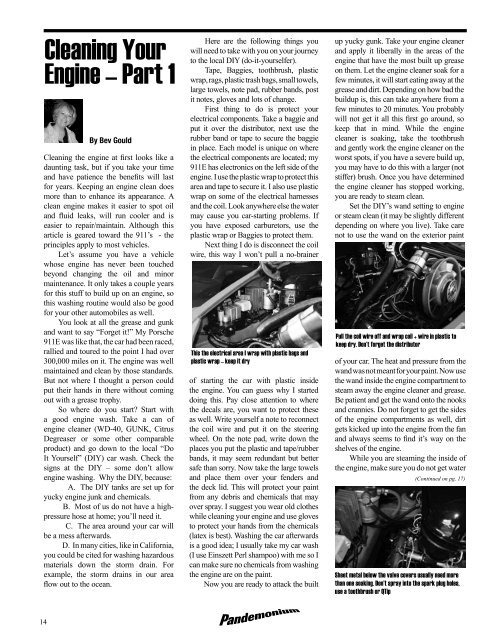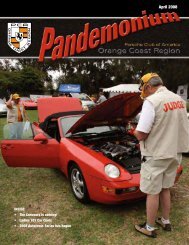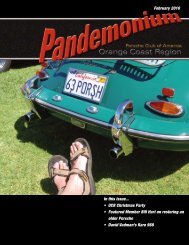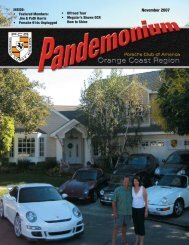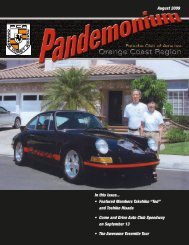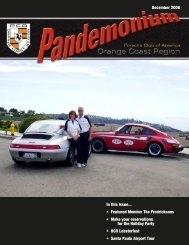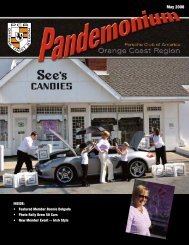September 2009 In this issue... • Featured Members Eric and Becky ...
September 2009 In this issue... • Featured Members Eric and Becky ...
September 2009 In this issue... • Featured Members Eric and Becky ...
Create successful ePaper yourself
Turn your PDF publications into a flip-book with our unique Google optimized e-Paper software.
Cleaning Your<br />
Engine – Part 1<br />
By Bev Gould<br />
Cleaning the engine at first looks like a<br />
daunting task, but if you take your time<br />
<strong>and</strong> have patience the benefits will last<br />
for years. Keeping an engine clean does<br />
more than to enhance its appearance. A<br />
clean engine makes it easier to spot oil<br />
<strong>and</strong> fluid leaks, will run cooler <strong>and</strong> is<br />
easier to repair/maintain. Although <strong>this</strong><br />
article is geared toward the 911’s - the<br />
principles apply to most vehicles.<br />
Let’s assume you have a vehicle<br />
whose engine has never been touched<br />
beyond changing the oil <strong>and</strong> minor<br />
maintenance. It only takes a couple years<br />
for <strong>this</strong> stuff to build up on an engine, so<br />
<strong>this</strong> washing routine would also be good<br />
for your other automobiles as well.<br />
You look at all the grease <strong>and</strong> gunk<br />
<strong>and</strong> want to say “Forget it!” My Porsche<br />
911E was like that, the car had been raced,<br />
rallied <strong>and</strong> toured to the point I had over<br />
300,000 miles on it. The engine was well<br />
maintained <strong>and</strong> clean by those st<strong>and</strong>ards.<br />
But not where I thought a person could<br />
put their h<strong>and</strong>s in there without coming<br />
out with a grease trophy.<br />
So where do you start? Start with<br />
a good engine wash. Take a can of<br />
engine cleaner (WD-40, GUNK, Citrus<br />
Degreaser or some other comparable<br />
product) <strong>and</strong> go down to the local “Do<br />
It Yourself” (DIY) car wash. Check the<br />
signs at the DIY – some don’t allow<br />
engine washing. Why the DIY, because:<br />
A. The DIY tanks are set up for<br />
yucky engine junk <strong>and</strong> chemicals.<br />
B. Most of us do not have a highpressure<br />
hose at home; you’ll need it.<br />
C. The area around your car will<br />
be a mess afterwards.<br />
D. <strong>In</strong> many cities, like in California,<br />
you could be cited for washing hazardous<br />
materials down the storm drain. For<br />
example, the storm drains in our area<br />
flow out to the ocean.<br />
Here are the following things you<br />
will need to take with you on your journey<br />
to the local DIY (do-it-yourselfer).<br />
Tape, Baggies, toothbrush, plastic<br />
wrap, rags, plastic trash bags, small towels,<br />
large towels, note pad, rubber b<strong>and</strong>s, post<br />
it notes, gloves <strong>and</strong> lots of change.<br />
First thing to do is protect your<br />
electrical components. Take a baggie <strong>and</strong><br />
put it over the distributor, next use the<br />
rubber b<strong>and</strong> or tape to secure the baggie<br />
in place. Each model is unique on where<br />
the electrical components are located; my<br />
911E has electronics on the left side of the<br />
engine. I use the plastic wrap to protect <strong>this</strong><br />
area <strong>and</strong> tape to secure it. I also use plastic<br />
wrap on some of the electrical harnesses<br />
<strong>and</strong> the coil. Look anywhere else the water<br />
may cause you car-starting problems. If<br />
you have exposed carburetors, use the<br />
plastic wrap or Baggies to protect them.<br />
Next thing I do is disconnect the coil<br />
wire, <strong>this</strong> way I won’t pull a no-brainer<br />
This the electrical area I wrap with plastic bags <strong>and</strong><br />
plastic wrap – keep it dry<br />
of starting the car with plastic inside<br />
the engine. You can guess why I started<br />
doing <strong>this</strong>. Pay close attention to where<br />
the decals are, you want to protect these<br />
as well. Write yourself a note to reconnect<br />
the coil wire <strong>and</strong> put it on the steering<br />
wheel. On the note pad, write down the<br />
places you put the plastic <strong>and</strong> tape/rubber<br />
b<strong>and</strong>s, it may seem redundant but better<br />
safe than sorry. Now take the large towels<br />
<strong>and</strong> place them over your fenders <strong>and</strong><br />
the deck lid. This will protect your paint<br />
from any debris <strong>and</strong> chemicals that may<br />
over spray. I suggest you wear old clothes<br />
while cleaning your engine <strong>and</strong> use gloves<br />
to protect your h<strong>and</strong>s from the chemicals<br />
(latex is best). Washing the car afterwards<br />
is a good idea; I usually take my car wash<br />
(I use Einszett Perl shampoo) with me so I<br />
can make sure no chemicals from washing<br />
the engine are on the paint.<br />
Now you are ready to attack the built<br />
up yucky gunk. Take your engine cleaner<br />
<strong>and</strong> apply it liberally in the areas of the<br />
engine that have the most built up grease<br />
on them. Let the engine cleaner soak for a<br />
few minutes, it will start eating away at the<br />
grease <strong>and</strong> dirt. Depending on how bad the<br />
buildup is, <strong>this</strong> can take anywhere from a<br />
few minutes to 20 minutes. You probably<br />
will not get it all <strong>this</strong> first go around, so<br />
keep that in mind. While the engine<br />
cleaner is soaking, take the toothbrush<br />
<strong>and</strong> gently work the engine cleaner on the<br />
worst spots, if you have a severe build up,<br />
you may have to do <strong>this</strong> with a larger (not<br />
stiffer) brush. Once you have determined<br />
the engine cleaner has stopped working,<br />
you are ready to steam clean.<br />
Set the DIY’s w<strong>and</strong> setting to engine<br />
or steam clean (it may be slightly different<br />
depending on where you live). Take care<br />
not to use the w<strong>and</strong> on the exterior paint<br />
Pull the coil wire off <strong>and</strong> wrap coil + wire in plastic to<br />
keep dry. Don’t forget the distributor<br />
of your car. The heat <strong>and</strong> pressure from the<br />
w<strong>and</strong> was not meant for your paint. Now use<br />
the w<strong>and</strong> inside the engine compartment to<br />
steam away the engine cleaner <strong>and</strong> grease.<br />
Be patient <strong>and</strong> get the w<strong>and</strong> onto the nooks<br />
<strong>and</strong> crannies. Do not forget to get the sides<br />
of the engine compartments as well, dirt<br />
gets kicked up into the engine from the fan<br />
<strong>and</strong> always seems to find it’s way on the<br />
shelves of the engine.<br />
While you are steaming the inside of<br />
the engine, make sure you do not get water<br />
(Continued on pg. 17)<br />
Sheet metal below the valve covers usually need more<br />
than one soaking. Don’t spray into the spark plug holes,<br />
use a toothbrush or QTip<br />
14


